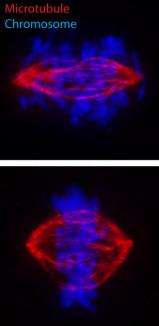New research shows key player in mitosis not required for chromosome alignment

(PhysOrg.com) -- K-fibers, structures long thought to play a key role in the alignment of chromosomes prior to cell division, are not required after all, say Indiana University and New York State Department of Health scientists.
In their report to Nature Cell Biology, available online but not yet in print, Claire Walczak, a cell biologist in IU Bloomington's Medical Sciences Program, IU biochemistry graduate student Shang Cai, and colleagues describe their series of experiments that conclusively show most chromosomes will move to the equator of the cell division apparatus -- in preparation for separation -- in the near- or total absence of k-fibers.
Until now, scientists who studied the cell division process, or mitosis, assumed k-fibers were essential for chromosomes to align themselves on a specialized structure called the mitotic spindle before the chromosomes are evenly divided and pulled to opposite sides of the cell.
"That was dogma in the field," Walczak said. "But we've learned chromosomes can find their way to the spindle equator without k-fibers, and that's not quite the whole story. We've also learned that without k-fibers, the chromosomes don't stay aligned very long. They wander off, which is obviously not very good for mitosis."
K-fibers attach to chromosomes via the kinetochore, an amalgam of proteins that serves as something of a chromosome handle. Prior to cell division, there are two kinetochore handles per chromosome, as chromosomes at this point in mitosis are actually Siamese twinlike pairs of identical genetic material joined at the hip, giving the chromosomes their familiar "X" shape.
Prior to the waist-tightening contraction that occurs as one spherical cell pinches off into two, all the chromosomes of a cell must be lined up at the parent cell's equator and split precisely so that each of the new cells has exactly the same amount (and kinds) of DNA.
Since k-fibers are intimately involved in the pulling apart of chromosomes, many scientists had assumed the k-fibers were also necessary for chromosome alignment, also known as chromosome congression.
In the experimentally forced absence of k-fibers, Walczak's team reports that most of the time, chromosomes still managed to find the spindle equator, probably through the direct interaction of the chromosome with the microtubules of the mitotic spindle.
"K-fibers certainly seem to ensure that the process goes more smoothly," Walczak said. "But the fact that a majority of chromosomes still makes it to the spindle equator proves that the k-fibers aren't absolutely required."
Walczak said the report confirms k-fibers are still required for the separation of chromosomes prior to the actual cell division event.
"You still need k-fibers to serve as a kind of 'checkpoint' before segregation," she said. "The attachment of k-fibers to the chromosome's two kinetochores is absolutely required. The cells without k-fibers simply didn't proceed to the next step."
Also contributing to the report were New York State Department of Health Wadsworth Center's Christopher O'Connell and Alexey Khodjakov. Research described in the Nature Cell Biology paper was supported by the National Institutes of Health.
Provided by Indiana University (news : web)

















